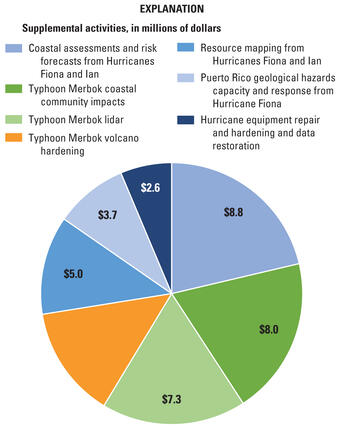2023 Supplemental Appropriation Activities
Title VII of Division N in the Consolidated Appropriations Act, 2023 (Public Law 117–328), was enacted on December 29, 2022. The USGS received $41.04 million in supplemental funding to support direct recovery and rebuilding decisions in the wake of declared disasters related to hurricanes and typhoons in 2022.
Specific activities funded in 2023

Sources/Usage: Public Domain. View Media Details
USGS disaster emergency supplemental activities funded under the Consolidated Appropriations Act include:
- Hurricane Equipment Repair and Hardening and Data Restoration
- Coastal Assessments and Risk Forecasts from Hurricanes Fiona and Ian
- Puerto Rico Geological Hazards Capacity and Response
- Resource Mapping in Florida and Puerto Rico
- Typhoon Merbok Volcano Hardening
- Typhoon Merbok Coastal Community Impacts
- Lidar for Typhoon Merbok
Related
Alaska Flood Staffs
The U.S. Geological Survey (USGS) uses observations of flooding in communities to monitor hazard conditions and support research by the USGS and its partners into a variety of hazard processes in Alaska. Local observations of flooding at a flood staffs are used to document flood elevations, improve flood models, and support floodplain management decisions.
Digital Shoreline Analysis System (DSAS)
Software for calculating positional boundary change over time The Digital Shoreline Analysis System (DSAS) version 6 is a standalone application that calculates shoreline or boundary change over time. The GIS of a user’s choice is used to prepare the data for DSAS. Like previous versions, DSAS v.6 enables a user to calculate rate-of-change statistics from multiple historical shoreline positions...
Chirp Sub-Bottom Profile Geophysical Data Collected in 2023 From the Chandeleur Islands, Louisiana
As part of the 2022 Disaster Supplemental project, scientists from the U.S. Geological Survey (USGS) St. Petersburg Coastal and Marine Science Center (SPCMSC) conducted a nearshore geophysical survey to map the shoreface and inner shelf, as well as characterize stratigraphy near the Chandeleur Islands, Louisiana (LA) in June and August 2023. The purpose of this study was to conduct a morphologic a
Consolidated Appropriations Act, 2023—USGS disaster emergency recovery activities
Title VII of Division N in the Consolidated Appropriations Act, 2023 (Public Law 117–328), was enacted on December 29, 2022. The U.S. Geological Survey received $41.04 million in disaster emergency supplemental funding for repairing and replacing facilities and equipment, collecting high-resolution elevation data in affected areas, and completing scientific assessments to support direct recovery a
Authors
Jo Ellen Hinck, Joseph Stachyra
Coastal Science Navigator companion guide—Discover the U.S. Geological Survey coastal science products you need
The Coastal Science Navigator is an online gateway to a wide variety of U.S. Geological Survey (USGS) coastal change hazards-related information, data, and tools relevant to stakeholders’ scientific and decision-making needs. The products within the Coastal Science Navigator provide data related to past, present, and future threats to our coastlines. The filter search allows users to see all avail
Authors
Mira Anderberg, Sara Ernst
Related
Alaska Flood Staffs
The U.S. Geological Survey (USGS) uses observations of flooding in communities to monitor hazard conditions and support research by the USGS and its partners into a variety of hazard processes in Alaska. Local observations of flooding at a flood staffs are used to document flood elevations, improve flood models, and support floodplain management decisions.
Digital Shoreline Analysis System (DSAS)
Software for calculating positional boundary change over time The Digital Shoreline Analysis System (DSAS) version 6 is a standalone application that calculates shoreline or boundary change over time. The GIS of a user’s choice is used to prepare the data for DSAS. Like previous versions, DSAS v.6 enables a user to calculate rate-of-change statistics from multiple historical shoreline positions...
Chirp Sub-Bottom Profile Geophysical Data Collected in 2023 From the Chandeleur Islands, Louisiana
As part of the 2022 Disaster Supplemental project, scientists from the U.S. Geological Survey (USGS) St. Petersburg Coastal and Marine Science Center (SPCMSC) conducted a nearshore geophysical survey to map the shoreface and inner shelf, as well as characterize stratigraphy near the Chandeleur Islands, Louisiana (LA) in June and August 2023. The purpose of this study was to conduct a morphologic a
Consolidated Appropriations Act, 2023—USGS disaster emergency recovery activities
Title VII of Division N in the Consolidated Appropriations Act, 2023 (Public Law 117–328), was enacted on December 29, 2022. The U.S. Geological Survey received $41.04 million in disaster emergency supplemental funding for repairing and replacing facilities and equipment, collecting high-resolution elevation data in affected areas, and completing scientific assessments to support direct recovery a
Authors
Jo Ellen Hinck, Joseph Stachyra
Coastal Science Navigator companion guide—Discover the U.S. Geological Survey coastal science products you need
The Coastal Science Navigator is an online gateway to a wide variety of U.S. Geological Survey (USGS) coastal change hazards-related information, data, and tools relevant to stakeholders’ scientific and decision-making needs. The products within the Coastal Science Navigator provide data related to past, present, and future threats to our coastlines. The filter search allows users to see all avail
Authors
Mira Anderberg, Sara Ernst



